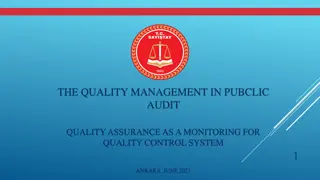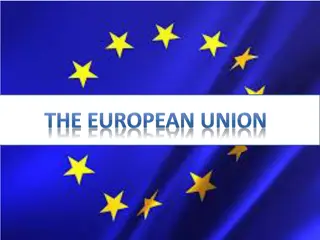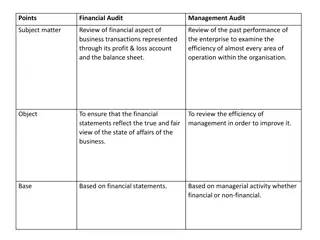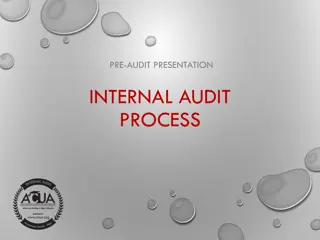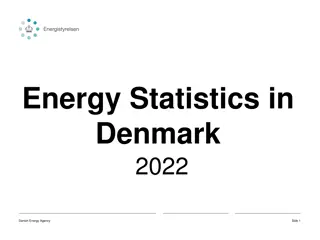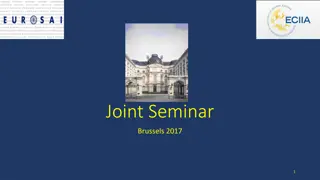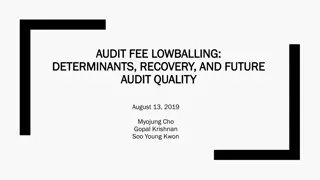Understanding Public Sector Performance Audit in Canada and Denmark
The study explores the legitimacy and apoliticality of Performance Auditing (PA) in Canada and Denmark, focusing on how Supreme Audit Institutions (SAIs) maintain political neutrality and legitimacy. Existing knowledge points to the inherent political nature of PA and the challenges SAIs face in preserving their credibility amid criticism. Theoretical frameworks on organizational legitimacy are used to analyze the findings from cases of the Canadian Auditor General and the Danish Rigsrevisionen. By examining similarities and differences in tradition, scope, and political systems, the research sheds light on the complex dynamics of PA in these countries.
Download Presentation

Please find below an Image/Link to download the presentation.
The content on the website is provided AS IS for your information and personal use only. It may not be sold, licensed, or shared on other websites without obtaining consent from the author. Download presentation by click this link. If you encounter any issues during the download, it is possible that the publisher has removed the file from their server.
E N D
Presentation Transcript
On the Legitimacy and Apoliticality of Public Sector Performance Audit: Exploratory Evidence from Canada and Denmark Mouna Hazgui, HEC Montreal Peter Triantafillou, Roskilde University Signe Helmer Christensen , Roskilde University
Background and Background and aim aim Background Performance Auditing (PA), which entails both the facilitation and the control of government policies, challenge state auditors claims that they are apolitical (Funnell et al., 2016; Grasso and Sharkansky, 2001; Kells, 2011; Radcliffe, 1999, etc.). Over the years, PA has been triggering mediatized clashes between political powers and some state auditors who were accused of political interference during their mandates (Morin and Hazgui, 2016; Triantafillou, 2017). Aim To understand how Supreme Audit Institutions (SAIs) operate to maintain and nurture the political neutrality and legitimacy of their PA.
Existing Existing knowledge knowledge PA is inherently political and sometimes deals with issues of the utmost sensitivity. Efforts to neutralize the work of auditors, or to adhere to simplistic notions of independence, seem doomed to frustration (Grasso and Sharkansky, 2001, p.16) Yet, SAIs must protect their political neutrality, even if it comes down to only protecting the appearance of apoliticality (Funnell, 1998). Failing that, the legitimacy and overall credibility of state auditors could be compromised (Gendron et al., 2007; Radcliffe, 1999). In sum: Much research exists questioning the political neutrality of PA Yet not been much on how SAIs have been able to develop and preserve the prevalent legitimacy of their PA amid the criticism.
Theory Theory Suchman s tri-partite typology on organizational legitimacy (1995) Legitimacy is subjective in the eyes of the organization s stakeholders Type of legitimacy Key characteristics Subcategories Calculated interests and answering of stakeholders Exchange Pragmatic legitimacy expectations. Influence Disposition Positive evaluation of the consequences, the Consequential Moral legitimacy organization s procedures or structure, or the Procedural personal qualities of the organization s members. Structural Personal Transparent, justified, and plausible actions. Comprehensibility Cognitive legitimacy Adequate competence. Taken-for-grantedness
Methods Methods - - cases cases PA reports of the Canadian Auditor General and the Danish Rigsrevisionen Both SAIs have a long history of both performance auditing and accusations of political interference Similarities Differences Tradition of PA Long traditions of PA. Legal mandates prohibiting SAIs from commenting on government policies. Westminster-style SAI with Both have a Westminster-style SAI with a The scope of the Canadian PAC is wider than PAC reportingto parliament PAC. that of the Danish one (OECD, 2002). Both the Canadian and the Danish PACs are The Danish PAC has very strong informal rules headed by a member of the opposition. of consensus. Political system Non-partisan, consensus-style government. Canada is a federal state; Denmark is a unitary one. Denmark has a long tradition of minority government and parliamentary cooperation.
Methods Methods - - data data Documents (2009-2018 both years included) Canada: 138 PA reports; the Canadian PA manual and Tweets Denmark: 199 SAI reports in which PA played a prominent role, along with 10 annual reports and 12 statements from the Auditor General (AG) to the public media. Interviews with SAI staff (PA auditors and information officers) Canada: 3 Denmark: 3
Findings Findings Legitimacy Legitimacy Main strategies identified Main critiques targeted category subcategory Influence legitimacy Engaging and maintaining dialogue with the The focus on sensitive areas to audit Maintaining administration PRAGMATIC legitimacy Dispositional legitimacy Consultations with experts and academics for The complexity and subjectivity of audits and external reviews evaluating efficiency Limited use of effect evaluations The complexity and subjectivity of evaluating efficiency Procedural and structural Adherence to well-recognized norms and The focus on sensitive areas to audit Securing MORAL legitimacy guidelines and to a code of professional conduct legitimacy Use of scientific and social science methods The complexity and subjectivity of evaluating efficiency Consequential legitimacy Careful formulation of the findings The political mediatization and instrumentalization of the findings Comprehensibility Legal authority, clarity, and succinct summaries The political mediatization and Aspiring for COGNITIVE instrumentalization of the findings Proper communication strategies legitimacy Comprehensibility Interdisciplinary requirements for auditors The complexity and subjectivity of evaluating efficiency Taken-for-grantedness Public interest / societal impact of the PA The focus on sensitive areas to audit
Conclusion Conclusion Both SAIs tend to underline the public interest dimension of their performance audits and their societal impacts in an attempt to increase both their legitimacy and political neutrality Two-fold strategies 1. Maintaining close dialogue with the audited administrations and illustrating the public interest facet of PA imply communicating and exposing the relevance of the audits 2. Strictly relying on legislation and well-recognized norms and involving external advisers and experts in the audits display the impartiality of the audits The strategies can be interpreted as trials and tests used to help SAIs navigate through the grey zone between relevant and politically sensitive audits (Christensen et al., 2002).
Research limitations The paper s explorative approach limits the possibility for robust testing of the causal forces impinging on SAIs choices of legitimation strategies. Variations between the Canadian and Danish SAIs in the strategic use of some legitimacy tools such as the media suggest a difference in the role of Public Accounts Committee in the two countries that can be investigated in future research










